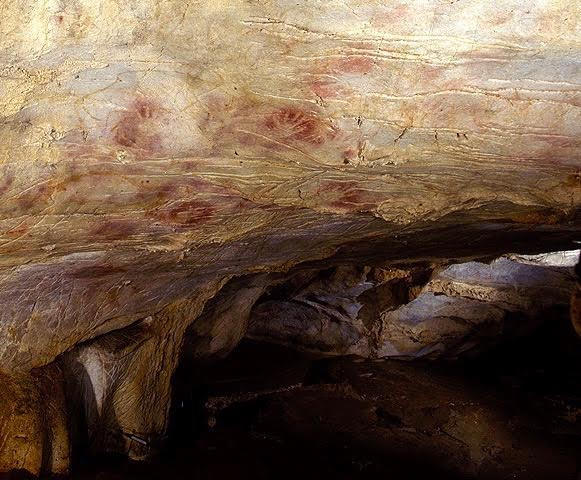 CUEVA DEL CASTILLOPUENTE VIESGO7 MAR 08
CUEVA DEL CASTILLOPUENTE VIESGO7 MAR 08 Human occupants of two caves in Northern Spain put some thought into where they placed their hand stencils on cave walls as much as 37,000 years ago, during Palaeolithic times. The topography and physical characteristics of the walls in the low light conditions of the caves seem to have mattered to them, suggest a team of researchers.
Led by Paul Pettitt of the U.K.’s Durham University, the team examined as many as 65 hand stencils, 27 in La Garma Cave, north of the village of Omoño in northern Spain near the coast, and 38 in El Castillo Cave, just southwest of La Garma in the village of Puente Viesgo. They recorded observations, such as color, left or right hand, length of the finger digits, width of the palms, orientation of the hands, and height above the cave floor. In addition, they examined the context of the stencils, such as the type of surface, the topography and natural features of the surface, and any association with other nearby cave art. Their study focused primarily on the contextual, as opposed to the characteristics of the stencils themselves.
What they found was a pattern that indicated selection or attention to certain types of natural cave wall features for placement of the stencils. “In total 80% of observable stencils at La Garma and 74% at El Castillo have some kind of association, either with fissures or undulations on the caves’ surfaces,” state the researchers in the study report. “Some stencils seem to have been ‘fitted’ to subtle topographic features in the wall, and some were positioned on bosses in the wall in such a manner that they appear to be ‘gripping’ the wall in a similar way that explorers use their hands to steady themselves when navigating the caves,” the study authors added.*
________________________________________
Above and below (close-up view), hand stencils in El Castillo Cave. Gabinete de Prensa del Gobierno de Cantabria, Wikimedia Commons
______________________________________________________
Moreover, under the low-light conditions of the caves, the authors suggest that the stencils were created using a significant reliance on touch and close-up scrutiny of the surface, in addition to overall visual facility.
Interestingly, the few hand stencils that were created in what would have been difficult or uncomfortable positions for the artists were clearly placed in association with certain types of natural features, such as atop a stalactite, associated with a crack, or ergonomically fitted to a concave surface with the fingers ‘gripping’ a boss.
The researchers also determined that more than one individual was making similar decisions about the placement of the stencils, indicating common or shared choices among a group of individuals.
In sum, the study authors assert that there is “much more to ‘cave art’ than meets the eye.”*
The study was published in Antiquity.
_____________________________________________________
* Paul Pettitt, et al., New views on old hands: the context of stencils in El Castillo and La Garma caves (Cantabria, Spain), Antiquity, Vol. 88 (2014): 47 – 63.
_____________________________________________________

______________________________________________
Travel and learn with Far Horizons.
____________________________________________
This richly illustrated issue includes the following stories: Recent findings shedding new light on the whereabouts of the remains of Philip of Macedon, father of Alexander the Great; how an archaeologist-sculptor is bringing bones of the dead back to life; archaeologists uncovering town life at the dawn of civilization; an exclusive interview with internationally acclaimed archaeologist James M. Adovasio about what makes the Meadowcroft Rockshelter prominent in the ongoing search for the first Americans; what archaeologists are finding at the site of the ancient city of Gath, the home town of the biblical Philistine giant, Goliath; and how scientists are redrawing the picture of human evolution in Europe. Find it on Amazon.com.










